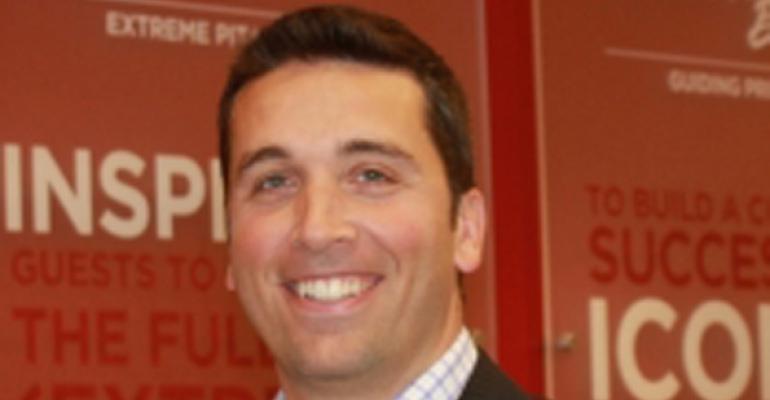The Extreme Pita rolled sandwich, salad and soup chain opened its fifth branch in a North American hospital on Oct. 24, when the brand debuted at Christus Spohn Hospital Corpus Christi-Shoreline in Corpus Christi, Texas.
RELATED
• Smokey Bones looks to menu to spur growth
• Inspections, streamlined menus key to Jimmy John's operations
• More restaurant industry growth concepts
Extreme Brandz Group of Companies of Mississauga, Ontario, oversees the essentially all-franchised Extreme Pita system of approximately 290 restaurants, including about 40 U.S. locations, and the 68-unit Mucho Burrito chain, which has three restaurants in Washington State. Some Extreme Pita locations are dual branded with the Pur Blendz smoothie concept also owned by Extreme Brandz, which, along with its franchising activities, operates six restaurants from its concept portfolio.
While the days-old Corpus Christi hospital location is franchised by Aramark, the Philadelphia-based on-site contract management company, other medical center units, including Sunnybrook Health Sciences Centre in Toronto, are licensed to Compass Group.
Extreme Brandz chief executive, president and co-founder, Alex Rechichi, noted that hospital sites can be challenging but they can also produce among the highest volumes reported within the Extreme Pita chain. That’s the case at Sunnybrook, which ranks among the system’s top 15 sales generators.
Rechichi said the Extreme Pita chain has average annual sales per unit of about $400,000 from facilities that typically take up 1,200 square feet and seat 24 to 26 people, garner roughly half of their income from takeout business and report a per-person average of approximately $9. Extreme Pita restaurants that co-brand with Pur Blendz typically produce an additional $50,000 to $60,000 in annual sales, he said.
Rechichi recently spoke with Nation’s Restaurant News about growing concepts in a hospital environment.
Why open a branded concept in hospitals?
The contract food providers managing these hospitals are looking to retain visitors and provide services, not just to those guests, but to patients as well, especially when they are in a long-term care facility.
Also I think hospitals today see the retailing opportunities that have presented themselves at other non-traditional venues, such as sports facilities and college campuses. They look at this as a way to broaden their retail horizon and introduce [outside] brands as part of their portfolio.
Can operators other than contractors open in hospitals?
It all depends on the arrangement at the hospital. With Aramark and Compass, part of their strategies called for broadening the retail portfolio at some hospitals [they manage] and they came to us with opportunities. But some other hospitals are looking to lease out space.
Is the hospital-restaurant niche a narrow one?
I think there are lots of possibilities. Hospitals are now trying to align themselves with brands that suit their purpose and mission to provide health care. So if yours is a brand like ours that provides food that is better for you and allows people a level of customization to meet their dietary needs, there is a huge opportunity. We’ve just started to tap into this.
What special considerations are necessary when opening in a hospital?
I’ll use Sunnybrook, as an example. We looked at its existing [visitor] traffic base, the number of different dayparts, the population of people who work there, the number of beds and the number of outpatients it serves — and that really determined the size of the prize, from a sales perspective. We looked at the facility itself, and this was a facility in which Compass invested money to update [and expand]. We ended up taking in our Extreme Pita brand, our Pur Blendz brand and one aspect of our menu –—our Extreme Flat Bakes, which are essentially pita pizzas — [that] we developed into its own separate kiosk.
The portability of the product is important, as is being able to serve people quickly. Often, people working in hospitals don’t have a lot of time to eat; they are on call and they want to get their food and be on their way.
Nutrition is also a big component. Providing nutritional disclosure is important, as we have done for many years.
Anything else?
Making sure that product innovation is occurring on a more frequent basis than it would in a traditional environment allows us to keep the menu fresh for people who work at a hospital or visit on a regular basis.
As a restaurant chain, we might be averaging up to four limited-time offers [a year], but in a hospital environment our mandate is to do one every couple of months, if not one monthly. Sometimes, we’ll focus on a bundled offering.
We put digital [display] screens in all of these hospitals so we can have that level of [promotional] flexibility.
Do hospital sites present marketing challenges?
Hospitals can be mazes, so if you are not at the immediate point of entry, where a lot of the traffic is coming in from, or where everybody goes for food at center court, there are definitely challenges in terms of letting people know you are there. It is a captive audience and its own community so it is important to focus on doing [promotional] things in the hospital on a frequent basis to make people aware of your presence.
The flip side of that is that there are hospitals where we’re at center court…where everybody goes for food. Sunnybrook is one of them. Corpus Christi is a new facility, so there is going to be a lot of attention paid to that. So from a marketing standpoint [in these facilities], it is all about building loyalty among people who are there by being able to service them quickly with a very good, fresh product.
Contact Alan J. Liddle at [email protected].
Follow him on Twitter: @AJ_NRN

